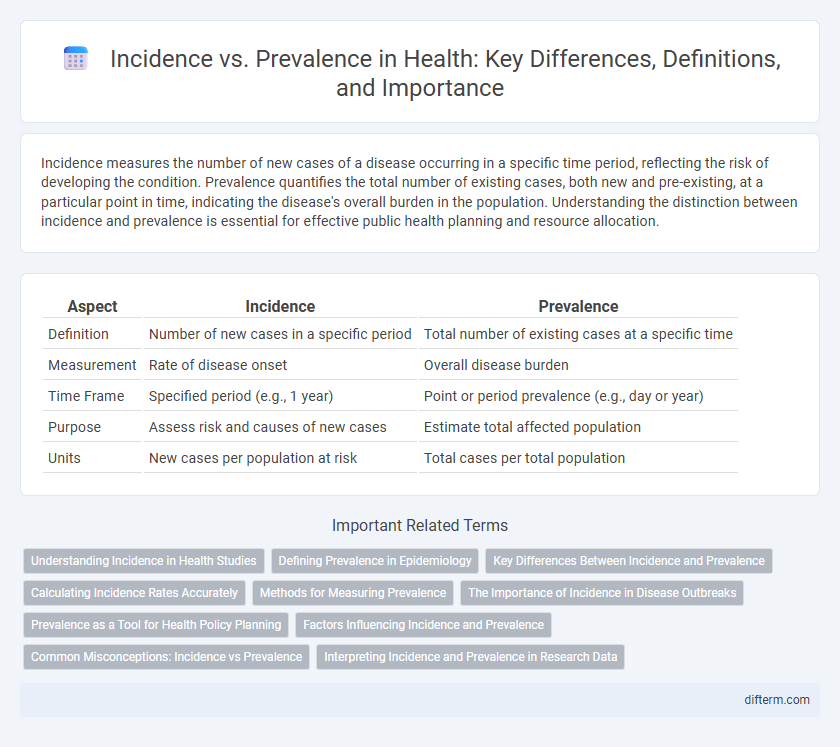Incidence measures the number of new cases of a disease occurring in a specific time period, reflecting the risk of developing the condition. Prevalence quantifies the total number of existing cases, both new and pre-existing, at a particular point in time, indicating the disease's overall burden in the population. Understanding the distinction between incidence and prevalence is essential for effective public health planning and resource allocation.
Table of Comparison
| Aspect | Incidence | Prevalence |
|---|---|---|
| Definition | Number of new cases in a specific period | Total number of existing cases at a specific time |
| Measurement | Rate of disease onset | Overall disease burden |
| Time Frame | Specified period (e.g., 1 year) | Point or period prevalence (e.g., day or year) |
| Purpose | Assess risk and causes of new cases | Estimate total affected population |
| Units | New cases per population at risk | Total cases per total population |
Understanding Incidence in Health Studies
Incidence measures the number of new cases of a disease or health condition occurring in a specified population during a defined time period, providing crucial insights into the risk and causality of diseases. It is expressed as an incidence rate, often per 1,000 or 100,000 individuals per year, and helps track the emergence of infectious diseases, chronic conditions, and the effectiveness of preventive interventions. Understanding incidence data enables health professionals to allocate resources efficiently and design targeted public health strategies.
Defining Prevalence in Epidemiology
Prevalence in epidemiology refers to the total number of existing cases of a specific disease or health condition within a defined population at a particular point in time or over a specified period. It provides a snapshot of the burden of disease, capturing both new and pre-existing cases. Prevalence is essential for assessing healthcare needs and allocating resources effectively.
Key Differences Between Incidence and Prevalence
Incidence measures the number of new cases of a disease occurring within a specific time period, reflecting the risk of developing the condition. Prevalence quantifies the total number of existing cases, both new and pre-existing, at a particular point in time, indicating the overall disease burden. Key differences include incidence's focus on rate and time frame, while prevalence captures the proportion of affected individuals in a population regardless of disease duration.
Calculating Incidence Rates Accurately
Calculating incidence rates accurately involves identifying new cases of a disease within a defined population during a specific time period, divided by the at-risk population at the start. Precise data collection and clear case definitions ensure that only new, not existing, cases contribute to the incidence rate, differentiating it from prevalence metrics. Accurate incidence rates inform public health interventions by reflecting the dynamic risk of disease transmission or onset.
Methods for Measuring Prevalence
Prevalence is measured using cross-sectional studies that assess the proportion of individuals with a specific health condition at a particular point or period. Population surveys, medical records, and health registries provide comprehensive data sources to estimate point prevalence and period prevalence accurately. The choice of measurement method depends on the condition's nature, available resources, and the required precision level for public health planning.
The Importance of Incidence in Disease Outbreaks
Incidence measures the rate of new disease cases occurring in a population during a specific time period, making it crucial for identifying and monitoring disease outbreaks. Tracking incidence helps public health officials detect emerging threats quickly, allocate resources effectively, and implement timely interventions to control spread. Unlike prevalence, which reflects total cases at a given time, incidence provides real-time data essential for outbreak response and epidemiological forecasting.
Prevalence as a Tool for Health Policy Planning
Prevalence measures the total number of existing cases of a disease within a population at a specific time, providing critical data for health policy planning. Public health officials utilize prevalence rates to allocate resources effectively, identify high-risk groups, and tailor intervention programs to control chronic conditions such as diabetes and hypertension. Accurate prevalence data supports long-term healthcare strategies by informing screening guidelines and preventive measures to reduce disease burden.
Factors Influencing Incidence and Prevalence
Incidence rates are influenced by factors such as exposure to risk, changes in diagnostic criteria, and population demographics, which affect the number of new cases over a specified period. Prevalence depends on incidence, duration of disease, and survival rates, reflecting the total number of existing cases in a population at a given time. Variations in healthcare access, treatment effectiveness, and disease chronicity also significantly impact prevalence levels in different communities.
Common Misconceptions: Incidence vs Prevalence
Incidence measures the number of new cases of a disease occurring in a specific population during a defined time period, while prevalence reflects the total number of existing cases at a given point in time. A common misconception is treating prevalence as an indicator of disease risk, when incidence is the more accurate metric for assessing new case occurrence. Understanding the distinction between these epidemiological measures is crucial for effective public health planning and resource allocation.
Interpreting Incidence and Prevalence in Research Data
Interpreting incidence involves measuring the number of new cases of a disease or condition within a specific time period, which aids in understanding risk factors and the speed of disease spread. Prevalence reflects the total number of existing cases, offering insights into the disease burden and resource allocation for healthcare services. Accurate interpretation of both metrics is crucial for designing effective public health interventions and evaluating treatment outcomes.
Incidence vs Prevalence Infographic

 difterm.com
difterm.com